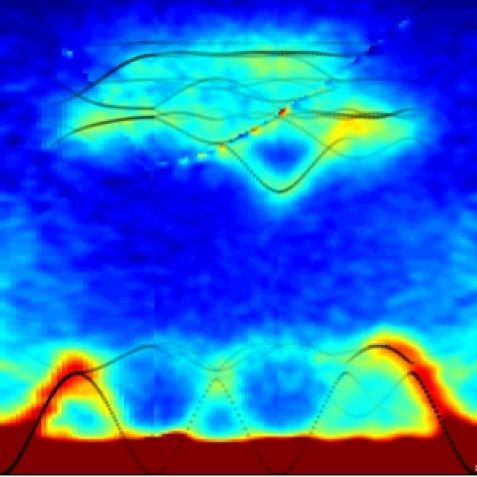MLZ is a cooperation between:
 > Technische Universität München
> Technische Universität München > Helmholtz-Zentrum Hereon
> Helmholtz-Zentrum Hereon
 > Forschungszentrum Jülich
> Forschungszentrum Jülich
MLZ is a member of:
 > LENS
> LENS > ERF-AISBL
> ERF-AISBL
MLZ on social media:

MLZ (eng)
Lichtenbergstr.1
85748 Garching
01.03.2016
The survey of copper selenate

Neutron scattering intensity distribution in energy-momentum space of copper selenate. © D. S. Inosov, TU Dresden
Physicists from TU Dresden, the Max-Planck-Institutes in Dresden and Stuttgart, and the Leibniz-Institut für Festkörper- und Werkstoffforschung achieved full understanding of magnetic interactions in copper selenate for the first time. For that matter, they have performed a series of inelastic neutron scattering experiments on three different spectrometers at MLZ and Oak Ridge National Laboratory (USA). On the time-of-flight spectrometer at ORNL, the 4-dimensional spectra were taken, while the three-ax spectrometers PUMA and PANDA were used to determine the important details.
Skyrmions were discovered experimentally in metals by the group of Prof. Christian Pfleiderer in 2009. Since then several other compounds are observed to show magnetic vortex structures. They are of huge interest not only for basic research, but also due to their potential as future applications in alternative magnetic data storage. Cu2OSeO3 is the first insulating compound with a complex three-dimensional magnetic structure showing a skyrmion lattice.
The vortex magnetic structure was observed in copper selenates in 2012 already. Theorists were able to model the magnetic behavior soon. The combination of different neutron methods allowed measuring the complete spectrum of magnetic excitations. By this, the existence of a large energy gap between different parts of the spectrum was confirmed, and the spectrum could be determined quantitatively. The resulting knowledge of exact positions of the dispersions and of the energy gap allowed accurately calculating the strength of the magnetic interactions. Therefore, this neutron scattering study gives an important impact for the understanding of skyrmion physics. Possibly furthermore, this understanding will finally help to develop alternative magnetic systems for data storage.
Original publication:
P. Y. Portnichenko, J. Romhányi, Y. A. Onykiienko, A. Henschel, M. Schmidt, A. S. Cameron, M. A. Surmach, J. A. Lim, J. T. Park, A. Schneidewind, D. L. Abernathy, H. Rosner, Jeroen van den Brink, and D. S. Inosov; Magnon spectrum of the helimagnetic insulator Cu2OSeO3, Nature Communications 7, 10725
MLZ is a cooperation between:
 > Technische Universität München
> Technische Universität München > Helmholtz-Zentrum Hereon
> Helmholtz-Zentrum Hereon
 > Forschungszentrum Jülich
> Forschungszentrum Jülich
MLZ is a member of:
 > LENS
> LENS > ERF-AISBL
> ERF-AISBL
MLZ on social media:



